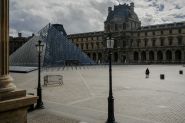In the shadow and light of paradise, the quest for the ultimate kiss of life leads us to a crossroads between celestial aspiration and earthly realities. Through the works of Liszt, Fauré, and Abou Mrad, this article explores, through music, the promise of eternal bliss and the transcendence of divine communion.
Paradise. A word that evokes such aspiration and fascination. And how! Is it not that breeze of hope that caresses the promise of infinite bliss? Whether perceived as a lush garden, a celestial realm, or spiritual fulfillment, paradise embodies, above all, perfect communion with a redeeming God, where blessed souls, freed from earthly constraints, revel in divine light.
Yet, since the dawn of time, this destiny has often served as a pretext for countless wars: multitudes of men have clashed, believing they were paving, or at least defending, the path to it. Artists, in search of this perfect elsewhere, have also drawn upon it for their most exalted dreams. In literature, paradise is adorned with a thousand and one metaphors, becoming alternately the utopia of the soul, the lost Eden, or the unreachable ideal. Dante Alighieri (1265–1321), in his Divine Comedy, describes it as a hierarchy of concentric heavens, each symbolizing a higher virtue, where the increasing light reflects proximity to the divine. For the Italian poet, paradise is not just a place of reward but also a realization of absolute truth and knowledge.
Over the centuries, many composers have endeavored to provide, through their works, a taste of this celestial harmony. This article will highlight three of these masterpieces: Franz Liszt’s Dante Symphony (1811-1886), the final movement (In Paradisum) of Gabriel Fauré’s Requiem in D minor, Op. 48 (1845-1924), and Dante e Beatrice: una lauda spirituala italo-levantina, a historically informed musicalization of excerpts from the Divine Comedy and verses by Abou Ala’ al-Maarri (973-1057), composed by Nidaa Abou Mrad.
Paradise Allusion
Liszt’s Dante Symphony explores themes of suffering, redemption, and the aspiration towards divine light. Although this choral symphony does not directly reference paradise, it evokes the quest for transcendence and the hope of eternal bliss, illustrating the spiritual journey that Dante himself described in his literary masterpiece. Created in 1857, Liszt's piece is divided into two main movements: L'Inferno ("Hell") and Purgatorio ("Purgatory"), followed by a Magnificat for women’s choir, often interpreted as an allusion to paradise. The first movement (L'Inferno) outlines the dark and tormented descent into hell.
Using dissonant harmonies, jerky rhythms, and violent descending motifs, Liszt reflects the terror and suffering of the damned. The second movement (Purgatorio) contrasts with the first by its more soothing and introspective tone. It depicts the ascent of souls towards purification, a kind of transition between the sufferings of hell and the bliss of paradise. Liszt uses gentler melodies and more consonant harmonies, hinting at a form of redemption and hope.
Although the Hungarian composer did not write a specific movement for paradise, the Magnificat at the end of Purgatorio is often interpreted as a symbolic opening towards paradise. This choral section, luminous and imbued with spirituality, suggests the promise of celestial peace and ultimate glorification. It can be seen as a foretaste of divine light and eternal harmony.
https://www.youtube.com/watch?v=A7x-la2AbjE
Lullabies for the Departed
Fauré’s Requiem in D minor, Op. 48, is a sacred music work composed between 1887 and 1891. Unlike traditional, often dramatic requiems, Fauré’s is characterized by an atmosphere of gentleness, serenity, and comfort. It is sometimes seen as a lullaby for the souls of the departed rather than a solemn invocation of the Last Judgment. The choice of certain texts, such as the In Paradisum that concludes the work, underscores this optimistic view of death as a passage to a state of divine tranquility.
The text of this final movement comes from an ancient liturgical antiphon traditionally sung at funerals. It depicts the image of angels guiding the soul of the deceased to paradise, a place of light and eternal peace. Fauré translates this celestial vision through soothing, gentle, and almost dreamlike music. The orchestration, sparse and subtle, uses the organ, strings, and sometimes the harp, creating a background that seems to float and envelop the angelic voices of the choir. The French composer infuses the In Paradisum with an atmosphere of transcendent peace, thus providing a luminous conclusion to his Requiem.
https://www.youtube.com/watch?v=flboe048gn4
Levantine Intonations
The Divine Comedy has not only inspired Western composers but also Levantine artists. In September 2021, on the occasion of the 700th anniversary of Dante Alighieri’s death, Nidaa Abou Mrad, Senior Professor at Sorbonne University and Dean of the Faculty of Music and Musicology at Antonine University, created a work entitled Dante e Beatrice: una lauda spirituala italo-levantina. This composition, inspired by the spiritual lauds of the Trecento, musicalizes excerpts from Dante’s Divine Comedy and verses by Abou Ala’ al-Maarri, an influential figure for Dante. The lauda, performed by the Ensemble de musique médiévale de l’Université Antonine, focuses on Beatrice’s guidance in Dante’s initiatory journey through Hell, Purgatory, and Paradise. For the musicalization of Dante's ancient Italian verses, four principles guide the composition.
First, Nidaa Abou Mrad uses the modes of the octoechos, inherited from the ecclesiastical musical traditions of the Levant and incorporating the modal scales of the first millennium. Second, he draws inspiration from Trecento Italian monodies, applying principles of modal generative musical grammar for precompositions and improvisations. Third, the singer (Rafka Rizk) adopts traditional singing techniques, perpetuated by ecclesiastical (Hellenophone and Syrianophone) and secular (Arabophone) modal monodic traditions of the Mediterranean basin. Finally, Trecento instruments, such as the bowed vielle, lute, and psaltery, are used according to traditional Arabic music techniques. The audible result is Italian singing and instrumentation with Levantine intonations, developing (in generative grammar) melodic formulations from medieval Italian music, reinterpreted through Mediterranean modal monodic traditions.
https://youtu.be/qxMUPKW9Q48?si=hPOaLXoq6EyEzaW-
Read more




Comments